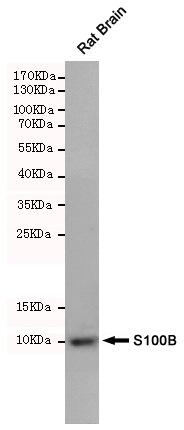-
Product Name
Anti-S100 beta (5G3) Mouse antibody
- Documents
-
Description
S100 beta (5G3) Mouse monoclonal antibody
-
Tested applications
WB
-
Species reactivity
Rat
-
Alternative names
NEF; Protein S100 B; Protein S100-B; S 100 calcium binding protein beta chain; S 100 protein beta chain; S-100 protein beta chain; S-100 protein subunit beta; S100; S100 calcium binding protein beta (neural); S100 calcium-binding protein B; S100 protein b antibody
-
Isotype
Mouse IgG2b
-
Preparation
Antigen: Human S100B synthetic peptide conjugated to KLH.
-
Clonality
Monoclonal
-
Formulation
Purified mouse monoclonal antibody in PBS(pH 7.4) containing with 0.03% Proclin300 and 50% glycerol.
-
Storage instructions
Store at 4°C short term. Store at -20°C long term. Avoid freeze / thaw cycle.
-
Applications
WB: 1/500
-
Validations

Western blot analysis of extracts from Rat Brain cell lysates using S100B mouse mAb (1:500 diluted).Predicted band size:10kDa.Observed band size:10kDa.
-
Background
Swiss-Prot Acc.P04271.Weakly binds calcium but binds zinc very tightly-distinct binding sites with different affinities exist for both ions on each monomer. Physiological concentrations of potassium ion antagonize the binding of both divalent cations, especially affecting high-affinity calcium-binding sites. Binds to and initiates the activation of STK38 by releasing autoinhibitory intramolecular interactions within the kinase. Interaction with AGER after myocardial infarction may play a role in myocyte apoptosis by activating ERK1/2 and p53/TP53 signaling. Could assist ATAD3A cytoplasmic processing, preventing aggregation and favoring mitochondrial localization. May mediate calcium-dependent regulation on many physiological processes by interacting with other proteins, such as TPR-containing proteins, and modulating their activity.
Related Products / Services
Please note: All products are "FOR RESEARCH USE ONLY AND ARE NOT INTENDED FOR DIAGNOSTIC OR THERAPEUTIC USE"
